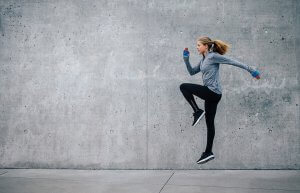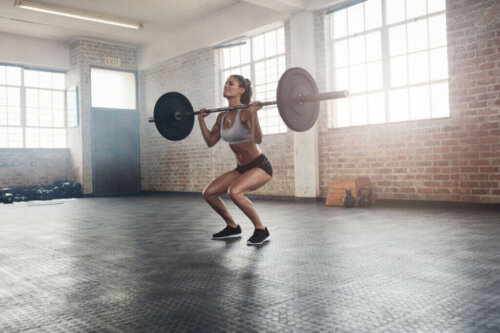Benefits of Adding Jumps to your Training Routine

Today, the axis of many training routines is strengthening your lower body. In this sense, jumping is a great way to pump your up while engaging several muscle groups. If you want to properly train your lower body and truly gain strength, adding jumps to your training routine is your best choice.
As you know, your lower body is largely responsible for your speed, strength, and agility. Adding jumps to your training routine not only makes your lower body more firm and lean while also greatly decreasing your risk of injury.
Jump training movements demand your muscles to work to their limits and push them even further, helping develop their maximum strength in a very short time. At the same time, we can use this type of exercise to speed up our heart-beat and train resistance.
Main benefits of adding jumps to your training routine
Here’s a list of the main benefits of adding jumps to your training routine:
- Stimulates your metabolism.
- Activates and stimulates the lymphatic system.
- Builds muscle. This helps you gain speed, as introducing jumps to your training routine will improve your cadence and stride.
- Increases heart rate and burns fat. Jumping training helps prevent cardiovascular disease by normalizing blood pressure. Also, it’s very effective to burn calories, in a 30-minute session you can burn up to 300 kcal.
- Improves strength. Jumps are very effective exercises to improve your strength. That’s why professional boxers often include jumping in their routines.
- Increases resistance. Adding jumps to your training will help to activate fast-twitch muscle fibers, resulting in muscular endurance. If we practice them constantly, the resistance will improve considerably.
- Prevents injury. Improving the calcium absorption, this results in a greater bone mass or, at least, in the reduction of bone loss in aging people.
- Jumping is fun. We cannot stress enough the importance of having fun while your train. Jumping makes your training routines more fun and easy to complete.

The importance of jumps in HIIT
HIIT means High-Intensity Interval Training. As you know, these workouts are a fantastic way to burn calories, build lean muscle and get fit — without spending hours in the gym.
The inclusion of jumps in HIIT training sessions is very important since these routines will make you fitter and stronger. HIIT training is based on aerobic exercise, and there are no better movements than jumps.
But, be aware, to endure a jumping workout, you must have certain physical conditions. We must keep in mind that this training is not suitable for anyone.
There are some people for which this type of exercise shouldn’t be used, especially those who suffer from joint conditions. People having some spinal pathology, such as hernias, scoliosis or problems in the ankles or knee joints should have routines especially designed and adapted.
Jumps and plyometric training
Plyometric exercises are those that consist of movements performed at the maximum possible speed. These exercises always aim to achieve maximum force production in the shortest period of time.
Indeed, the training method in which jumps are a key element belongs to plyometric training. Jumping training includes routines based on explosive movements and, in most cases, using weights or dumbbells. Squats are a great example of plyometric exercises that can be harder with the use of added weight.
The main mission of plyometric exercises is to stimulate potency. Additionally, this work will also help us improve endurance, explosiveness, strength, and performance in general.
So if you’re looking for an efficient workout you can do anywhere — with or without equipment — adding jumps to your training routine can be the best choice for you.
Five jumping exercises you should try
If you’re tempted to try adding jumps to your training routine, you can begin with the following exercises:
1. Knee jumps:
Once you get in a semi-squat position, you’re ready to complete the jump: raise both legs at the same time as high as you can, ideally your knees will touch your chest.
It’ll be key, not only in this but in any jump, to be able to properly cushion the impact that occurs when you fall to the ground.
2. Box jumps:
The movement itself is the same as the previous one, but with a small upward and forward movement. You’ll finish with both legs at the same time on the box. In addition, this exercise will allow you to quantify and evaluate performance in multiple sports disciplines.

3. Burpee jump:
In this version of the exercise, a jump is added at the end of the movement, to reach as high as possible. This variant makes the burpee even more complete by adding legs, and in particular the quadriceps and calf muscles, to the other working muscles, such as the deltoids, pectorals, and triceps. Therefore, it’s another good tool to include exercises with jumps in training.
4. Jumping squats:
Stand with your feet shoulder-width apart. Now, start by doing a regular squat, then engage your core and jump up explosively.
Again, when you land, lower your body back into the squat position to complete one rep. Land as quietly as possible, which requires control.
5. Jumping lunges
The jumping lunges are a good exercise for both your inner and outer thighs and also helps to work your heart and lungs. Lunges can also be part of a dynamic warm-up.
These are some old school military-style movements, which are still in use today, just as the dreaded push-ups. This exercise is very similar to a squat, with a small difference: you have to keep your balance.
To make these lunges, you must jump and fall back down with one leg forward and one leg bent to your back. Both knees should be bent at a 90-degree angle. Then, jump and scissor your legs, always keeping your balance.
Conclusions about training jumps
As you’ve seen, adding jumps to your training routine gives you a series of amazing benefits. However, bear in mind that these jumps aren’t always easy to perform.
Although we all know how to jump, we must have a good technique to prevent injuries and so that the objective we seek is achieved correctly. Don’t hesitate to take advice from a trusted professional, and jump!
Today, the axis of many training routines is strengthening your lower body. In this sense, jumping is a great way to pump your up while engaging several muscle groups. If you want to properly train your lower body and truly gain strength, adding jumps to your training routine is your best choice.
As you know, your lower body is largely responsible for your speed, strength, and agility. Adding jumps to your training routine not only makes your lower body more firm and lean while also greatly decreasing your risk of injury.
Jump training movements demand your muscles to work to their limits and push them even further, helping develop their maximum strength in a very short time. At the same time, we can use this type of exercise to speed up our heart-beat and train resistance.
Main benefits of adding jumps to your training routine
Here’s a list of the main benefits of adding jumps to your training routine:
- Stimulates your metabolism.
- Activates and stimulates the lymphatic system.
- Builds muscle. This helps you gain speed, as introducing jumps to your training routine will improve your cadence and stride.
- Increases heart rate and burns fat. Jumping training helps prevent cardiovascular disease by normalizing blood pressure. Also, it’s very effective to burn calories, in a 30-minute session you can burn up to 300 kcal.
- Improves strength. Jumps are very effective exercises to improve your strength. That’s why professional boxers often include jumping in their routines.
- Increases resistance. Adding jumps to your training will help to activate fast-twitch muscle fibers, resulting in muscular endurance. If we practice them constantly, the resistance will improve considerably.
- Prevents injury. Improving the calcium absorption, this results in a greater bone mass or, at least, in the reduction of bone loss in aging people.
- Jumping is fun. We cannot stress enough the importance of having fun while your train. Jumping makes your training routines more fun and easy to complete.

The importance of jumps in HIIT
HIIT means High-Intensity Interval Training. As you know, these workouts are a fantastic way to burn calories, build lean muscle and get fit — without spending hours in the gym.
The inclusion of jumps in HIIT training sessions is very important since these routines will make you fitter and stronger. HIIT training is based on aerobic exercise, and there are no better movements than jumps.
But, be aware, to endure a jumping workout, you must have certain physical conditions. We must keep in mind that this training is not suitable for anyone.
There are some people for which this type of exercise shouldn’t be used, especially those who suffer from joint conditions. People having some spinal pathology, such as hernias, scoliosis or problems in the ankles or knee joints should have routines especially designed and adapted.
Jumps and plyometric training
Plyometric exercises are those that consist of movements performed at the maximum possible speed. These exercises always aim to achieve maximum force production in the shortest period of time.
Indeed, the training method in which jumps are a key element belongs to plyometric training. Jumping training includes routines based on explosive movements and, in most cases, using weights or dumbbells. Squats are a great example of plyometric exercises that can be harder with the use of added weight.
The main mission of plyometric exercises is to stimulate potency. Additionally, this work will also help us improve endurance, explosiveness, strength, and performance in general.
So if you’re looking for an efficient workout you can do anywhere — with or without equipment — adding jumps to your training routine can be the best choice for you.
Five jumping exercises you should try
If you’re tempted to try adding jumps to your training routine, you can begin with the following exercises:
1. Knee jumps:
Once you get in a semi-squat position, you’re ready to complete the jump: raise both legs at the same time as high as you can, ideally your knees will touch your chest.
It’ll be key, not only in this but in any jump, to be able to properly cushion the impact that occurs when you fall to the ground.
2. Box jumps:
The movement itself is the same as the previous one, but with a small upward and forward movement. You’ll finish with both legs at the same time on the box. In addition, this exercise will allow you to quantify and evaluate performance in multiple sports disciplines.

3. Burpee jump:
In this version of the exercise, a jump is added at the end of the movement, to reach as high as possible. This variant makes the burpee even more complete by adding legs, and in particular the quadriceps and calf muscles, to the other working muscles, such as the deltoids, pectorals, and triceps. Therefore, it’s another good tool to include exercises with jumps in training.
4. Jumping squats:
Stand with your feet shoulder-width apart. Now, start by doing a regular squat, then engage your core and jump up explosively.
Again, when you land, lower your body back into the squat position to complete one rep. Land as quietly as possible, which requires control.
5. Jumping lunges
The jumping lunges are a good exercise for both your inner and outer thighs and also helps to work your heart and lungs. Lunges can also be part of a dynamic warm-up.
These are some old school military-style movements, which are still in use today, just as the dreaded push-ups. This exercise is very similar to a squat, with a small difference: you have to keep your balance.
To make these lunges, you must jump and fall back down with one leg forward and one leg bent to your back. Both knees should be bent at a 90-degree angle. Then, jump and scissor your legs, always keeping your balance.
Conclusions about training jumps
As you’ve seen, adding jumps to your training routine gives you a series of amazing benefits. However, bear in mind that these jumps aren’t always easy to perform.
Although we all know how to jump, we must have a good technique to prevent injuries and so that the objective we seek is achieved correctly. Don’t hesitate to take advice from a trusted professional, and jump!
All cited sources were thoroughly reviewed by our team to ensure their quality, reliability, currency, and validity. The bibliography of this article was considered reliable and of academic or scientific accuracy.
- Anek, A., Kanungsukasem, V., & Bunyaratavej, N. (2011). Effects of the circuit box jumping on bone resorption, health-related to physical fitness and balance in the premenopausal women. Journal of the Medical Association of Thailand= Chotmaihet thangphaet, 94, S17-23.
- Gross, M., Hoppeler, H., & Vogt, M. (2014). Quantification of the Metabolic and Physical Demands of the 90-Second Box Jump. J Athl Enhancement 3: 2. of, 7, 2.
- Khodaei, K., Mohammadi, A., & Hamedinia, M. R. (2017). Evaluation of plyometric exercises intensity using ratings of perceived exertion scale. MEDICINA DELLO SPORT, 70(3), 299-306.
- Tran, T., Faulkinbury, K., Stieg, J., Khamoui, A. V., Uribe, B. P., Dabbs, N. C., … & Judelson, D. A. (2010). Effect Of 10 Repetitions Of Box Jumps And Depth Jumps On Peak Ground Reaction Force. The Journal of Strength & Conditioning Research, 24, 1.
This text is provided for informational purposes only and does not replace consultation with a professional. If in doubt, consult your specialist.








